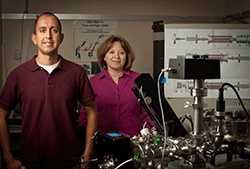Chemical Imaging Research Area

Researchers have long wanted to "see" chemical, materials, and biochemical processes, in time and space, with enough detail to determine what is occurring at the molecular level. This level of information will allow scientists and engineers to move from observing chemical, materials, and biological processes to controlling them. But, they lack the tools to reach this level of clarity, specifically for processing under operating conditions. Instead, they must infer what is happening from secondary sources and mathematical models. Data from multiple experimental tools are needed to significantly advance this capability.
In collaboration with U.S. and UK universities, scientists at the Pacific Northwest National Laboratory are inventing the tools and techniques to generate in situ or in-place images at the nanometer and near-nanometer scales. This work is done using resources at EMSL, PNNL, and synchrotron radiation light sources.
As an example, imaging researchers obtained nanometer-scale images of environmental particles linked to climatic and health problems. At the near-nanometer scale, researchers are developing a robust method to quantify atomic-scale changes at energy storage material interfaces using the new generation of aberration-corrected microscopes and in situ stages. They are also building the computational tools to speed analysis of the massive data streams.
This work is funded by the Laboratory Directed Research and Development Office at PNNL. Additional funding comes from other research grants from the U.S. Department of Energy and other sources.
Related Highlights
- Seeing the Forest and the Trees to Find Parasitic Reactions that Lead to Battery Failure
- Of Catalysts and Coke
- Yu, Zhu Research Graced Chemical Communications Back Cover
- Imaging Results Are Ones for the Books
- PNNL-led Science Team Pioneers Approach to Study Cells at Molecular Level
- Xiao-Ying Yu Leads Team, Granted New Patent
- Low-cost and Lightweight
- Transformations: Waste as Energy and Opportunity, Inventions in Catalysis, ACS Catalysis Lectureship Winners Interview
- Lou Terminello Elected AAAS Fellow
- The Color of Smog
- Better Batteries
- Better Views of Slimy Substances
- Transformations: Focus on Zeolites, Catalysis at ACS Meeting, Exploring Molecular Channels
- From Fire to Ice
- Finding the Missing Particles
- Putting Batteries on Stage Spotlights Performance at the Nanoscale
- Transformations: The Value of Catalysis, Top Five List from CME's Last Five Years, Catalytic Choreography
- Cross-institutional Team Demonstrations Tackle Big Data Challenges in Materials Science
- Xiao-Ying Yu Led Team Winning Federal Excellence in Technology Transfer Award
- Duets by Molecules and Plasmons
- How Sea Spray Particles Evolve in the Atmosphere
- 2014 Key Scientific Accomplishments Report Now Available
- Taking Back the Angels' Share of Atoms
- Seeing Clearly Through a Liquid
- Layla Mehdi Receives Scholarship for Microscopy Conference
- Watching Nanoparticles Swim
- New Imaging Approach Accurately Measures Lipid and Metabolite Distributions in Biological Samples
- Julia Laskin Receives Laboratory Director's Science and Engineering Achievement Award
- Transformations: Changing the Game in Biomass Conversion, Molecular Road Rage, and Long-Lived Biofuel Catalysts
- Degradation Mechanisms Uncovered in Li-Ion Battery Electrolytes
- By Losing Their Shape, Material Fails Batteries
- In Situ Chemical Imaging at the Sub-Biofilm-Scale Now Possible
- Watching Nanoparticles Grow
- Batteries as They Are Meant To Be Seen
- Microfluidic Probe Allows Real-Time Imaging of Electrode-Liquid Electrolyte Interface
- The Character of a Cathode
- New Technique Efficiently Resolves Chemistry of Nanoparticles
- Arslan's Research Graces the North American Catalysis Society Meeting's Program
- New Imaging Tool Directly Measures Liquid Surfaces
- Microfluidic Devices Move from Application to Fundamental Science
- Motivating Carbon Dioxide
- Nigel Browning Elected Microscopy Society of America Fellow
- Observing Chemistry of Atmospheric Particles and Droplets with New Mass Spectrometry Techniques
- Seeing the Messages Microbes Send
- Nigel Browning Discusses Watching Atoms Move at AAAS 2013
- Catalyst Becomes More Selective After Oxygen Atoms' Departures
- Seeing a Common Catalyst with New Eyes
- Batteries Lose in Game of Thorns
- Wayne Hess Named American Physical Society Fellow
- Nigel Browning Named AAAS Fellow
- Pollution Hitches Ride to Arctic
- Getting a Quick View of Data
- Fundamental Science Artfully Displayed in Calendar and Traveling Exhibit
- 2012 Fundamental & Computational Sciences Accomplishments Report Now Available
- Nickelblock: An Element's Love-hate Relationship with Battery Electrodes
- Team Wins 2012 Innovation Award
- Listening to Life
- Silicon-carbon Electrodes Snap, Swell, Don't Pop
- A Pop Quiz for Cells
- A Better Look at the Brain
- Brighter is Better
